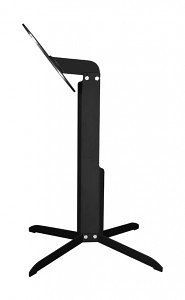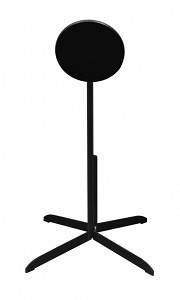Action Target is pleased to announce the release
 of the new 45 Degree Static
of the new 45 Degree Static![]() . Now you can shoot on steel with high-powered rifles at close range!
. Now you can shoot on steel with high-powered rifles at close range!
The 45 Degree Static is the newest member of the AT Static family. With an AR 550 armor steel head plate slanted at 45 degrees, this static target is specifically designed for shooting high-powered rifles* at close distances. Most steel targets, even those made of AR550 armor steel, don’t stand up well to the power of rifle ammunition when shot from distances closer than 100 yards, but the 45 Degree Static’s unique design allows it to absorb the impact of high-powered ammunition from as close as 50 yards.
The 45 Degree Static uses a high angle of deflection to force bullet fragments down toward the feet of the target. Because the steep angle of the target spreads bullet impact over a larger surface area, the 45 Degree Static is perfectly capable of handling .223, .308, and even slugs from only 50 yards, giving you greater training freedom in a smaller area. The head plate is 14” tall and 12” wide making it elliptical in shape, but the steep slant makes it appear perfectly round to a shooter standing 50 yards away.
Just like our standard AT Static targets![]() , the head plate of the 45 Degree Static is mounted to the stand so it bounces when hit, giving you immediate visual feedback and positive reinforcement for accurate shots. The head plate of the target is completely flat with no exposed bolts, clamps, or brackets to cause unpredictable splatter when inevitably hit, and the low profile bullet-shedding stand helps make this one of the most durable targets on the market.
, the head plate of the 45 Degree Static is mounted to the stand so it bounces when hit, giving you immediate visual feedback and positive reinforcement for accurate shots. The head plate of the target is completely flat with no exposed bolts, clamps, or brackets to cause unpredictable splatter when inevitably hit, and the low profile bullet-shedding stand helps make this one of the most durable targets on the market.
*The 45 Degree Static is made of 3/8” thick AR550 armor steel and is designed for use with ammunitions that have a muzzle velocity less than 3,000 fps. Using ammunition that exceeds this limit may result in damage to the target.







Awesome idea! I would like to see an “8 inch” plate, and I would like you to publish an acceptable distance for standard .223 velocities from an 18-20 inch AR platform (3250 FPS?). When you get into the lighter bullets and longer barrels .223 can reach 3700 FPS.
David,
We are currently working on doing some research on the effects of different muzzle velocities and shooting distances on AR550 steel. As of yet, we haven’t ruined enough of our targets to accurately say what an acceptable distance is for shooting steel with 3,000+ fps ammo. This is one of our weaknesses we’re trying to rectify. For the time being, however, I would leave the target destroying to us and avoid using anything over 3,000 fps.
Finally! I shoot on private property and only have a 50 yard line of sight. I have several steel targets from Action, but have to limit their use to handguns because of distance. I’ve looked high and low for a steel target that’s rated for rifles under 100 yards. I’ll be purchasing this product as soon as I have the money.
Trav,
Glad we could provide the target you’ve been looking for. It was actually people just like you we had in mind when designing this target.
This definitely interests me, but the 3000 fps limit is a sticking point. All of the military-type full metal jacket 5.56mm ammunition I use for training and practice runs 3K or faster from a 16 inch barrel.
John,
This is one of the inherent difficulties when it comes to shooting on steel. AR550 steel is just hard enough to withstand direct contact from ammunition with a muzzle velocity of 3,000 fps and under. Any harder and the steel becomes too brittle to absorb bullet impact. But even at that hardness rating, ammunition that exceeds 3,000 fps will dent and damage the target. While the 45 degree angle of the head plate dissipates much of the bullet’s energy, it does have its limits. We are currently working on testing with high-velocity rounds to determine exactly how much ballistic energy our steel targets are able to withstand.
Sir,
We use 12 stands with two full sets of head plates and a dueling tree for our pistol classes.
We have 12 550 hardness large pepper poppers for 100 yard plus shooting in our rifle classes. We currently switch to paper targets for 50 yard rifle shooting. We look forward to the results of your testing of the new target. These new targets could be ideal for our classes. Question: what is the potential for damage should the vertical stand be hit just below the head plate?
Thank you for your great products and your time to answer our question.
Larry Mudgett
Marksmanship Matters LLC
Larry,
Our target stands are all made of mild steel, so they are susceptible to damage if hit. Making the stands of armor steel wouldn’t be practical due to the high cost and increased weight. We’ve designed the stands, however, in a way that makes them very low profile to diminish the off chance of getting hit. If a bullet does happen to hit the edge, the damage isn’t nearly as bad as if it hit the side of the stand. So, in answer to your question, the stands are not made to take direct hits but are designed to lower the chances of that happening. If you do happen to damage a piece of your target, we are releasing a new version of the online store in the near future. The new store will feature the option to purchase target parts individually. Let me know if there is anything you need in the meantime.
I appreciate it for writing “New Product: Action Target Introduces
New 45 Degree Static Target : Action Target”.
I really may certainly be coming back for alot more reading and writing comments
in the near future. Thank you, Shayne
Ok, great information here but the question I have is will the target be ok shooting .223 SS109 62 gr steel core ammo at 50 yards or would you suggest moving it out to 100. I just received my target and excited about breaking it in. Should I just try it at 50 and see if it damages the target. I read the piece about longer barrels and lighter bullets but what about the SS109. Thanks
Kyle, I hope you haven’t gone shooting yet, because you might just ruin your target. You should never shoot steel core ammo at steel targets. The whole point of steel core ammo is armor penetration (including steel). The 45 Degree Static will absolutely be damaged if you’re shooting it with that kind of ammo. As far as muzzle velocity, that grain of .223 is pushing the limit. It’s hard to give you an exact number on that because, like you said, muzzle velocity is affected by barrel length as well as altitude, humidity, barometric pressure, etc. If you’re approaching that 3,000 fps limit (with a , you will probably need to move back to 100 yards with the 45 Degree Static.
For more information, please refer to the Steel Resource Guide: https://f3e21fcc14.nxcli.net/wp-content/uploads/2010/10/pt_Steel_Target_Resource_Guide.pdf